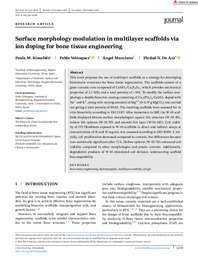Por favor, use este identificador para citar o enlazar este ítem:
https://hdl.handle.net/11000/34031Registro completo de metadatos
| Campo DC | Valor | Lengua/Idioma |
|---|---|---|
| dc.contributor.author | Riosalido, Paula M. | - |
| dc.contributor.author | Velásquez, Pablo | - |
| dc.contributor.author | Murciano, Ángel | - |
| dc.contributor.author | De Aza, Piedad | - |
| dc.contributor.other | Departamentos de la UMH::Ciencia de Materiales, Óptica y Tecnología Electrónica | es_ES |
| dc.date.accessioned | 2024-11-27T08:35:55Z | - |
| dc.date.available | 2024-11-27T08:35:55Z | - |
| dc.date.created | 2024-11-25 | - |
| dc.identifier.citation | Journal of the American Ceramic Society, 2024 | es_ES |
| dc.identifier.issn | 1551-2916 | - |
| dc.identifier.issn | 0002-7820 | - |
| dc.identifier.uri | https://hdl.handle.net/11000/34031 | - |
| dc.description.abstract | This work proposes the use of multilayer scaffolds as a strategy for developing biomimetic structures for bone tissue regeneration. The scaffolds consist of a glass–ceramic core composed of CaSiO3/Ca2P6O17, which provides mechanical properties of 2.3 MPa and a total porosity of ∼74%. To modify the surface morphology a double bioactive coating consisting of Ca3(PO4)2/CaSiO3 doped with Na+ and K+, along with varying amounts of Mg2+ (0–0.75 g MgCO3) was carried out giving a total porosity of 89.8%. The resulting scaffolds were assessed for in vitro bioactivity according to ISO 23317. After immersion in SBF, the W-05 scaffolds displayed diverse surface morphologies: square HA structure (W-05-3D), hollow HA spheres (W-05-7D) and smooth HA layer (W-05-21D). Cell viability of 3T3 fibroblasts exposed to W-05 scaffolds in direct and indirect assays at concentrations of 15 and 30 mg/mL was assessed according to ISO 10993–5. Initially, cell proliferation decreased compared to controls, but differences became non-statistically significant after 72 h. Hollow spheres (W-05-7D) enhanced cell viability compared to other morphologies and plastic controls. Additionally, degradation products of W-05 stimulated cell division, underscoring scaffold biocompatibility. | es_ES |
| dc.format | application/pdf | es_ES |
| dc.format.extent | 15 | es_ES |
| dc.language.iso | eng | es_ES |
| dc.publisher | Wiley | es_ES |
| dc.rights | info:eu-repo/semantics/openAccess | es_ES |
| dc.rights | Attribution-NonCommercial-NoDerivatives 4.0 Internacional | * |
| dc.rights.uri | http://creativecommons.org/licenses/by-nc-nd/4.0/ | * |
| dc.subject | bone tissue engineering | es_ES |
| dc.subject | hydroxyapatite | es_ES |
| dc.subject | multilayer scaffolds | es_ES |
| dc.subject | sol-gel | es_ES |
| dc.subject.other | CDU::6 - Ciencias aplicadas | es_ES |
| dc.title | Surface morphology modulation in multilayer scaffolds via ion doping for bone tissue engineering | es_ES |
| dc.type | info:eu-repo/semantics/article | es_ES |
| dc.relation.publisherversion | https://doi.org/10.1111/jace.20269 | es_ES |

Ver/Abrir:
2024-JACS-Paula.pdf
3,08 MB
Adobe PDF
Compartir:
 La licencia se describe como: Atribución-NonComercial-NoDerivada 4.0 Internacional.
La licencia se describe como: Atribución-NonComercial-NoDerivada 4.0 Internacional.
.png)